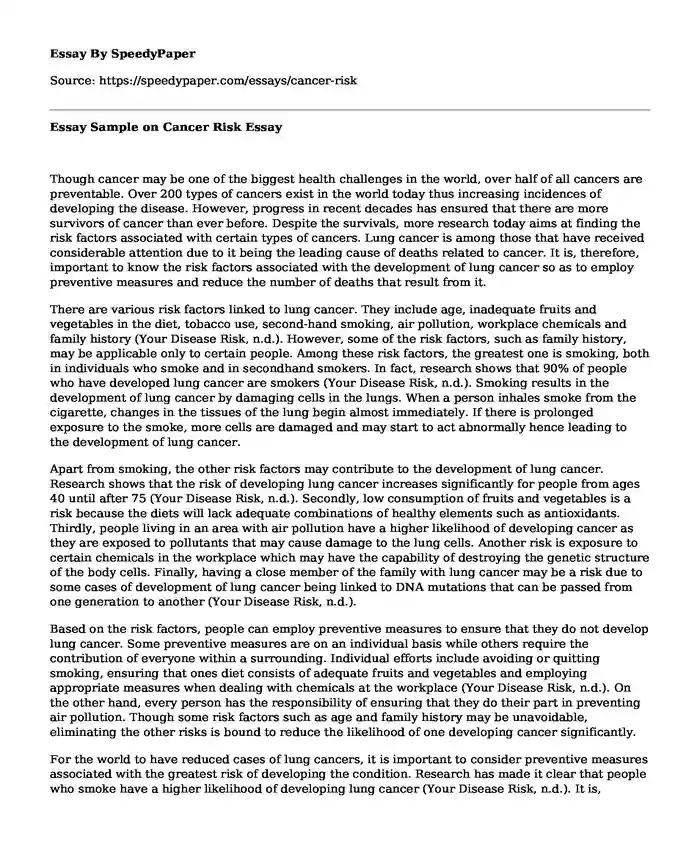Though cancer may be one of the biggest health challenges in the world, over half of all cancers are preventable. Over 200 types of cancers exist in the world today thus increasing incidences of developing the disease. However, progress in recent decades has ensured that there are more survivors of cancer than ever before. Despite the survivals, more research today aims at finding the risk factors associated with certain types of cancers. Lung cancer is among those that have received considerable attention due to it being the leading cause of deaths related to cancer. It is, therefore, important to know the risk factors associated with the development of lung cancer so as to employ preventive measures and reduce the number of deaths that result from it.
There are various risk factors linked to lung cancer. They include age, inadequate fruits and vegetables in the diet, tobacco use, second-hand smoking, air pollution, workplace chemicals and family history (Your Disease Risk, n.d.). However, some of the risk factors, such as family history, may be applicable only to certain people. Among these risk factors, the greatest one is smoking, both in individuals who smoke and in secondhand smokers. In fact, research shows that 90% of people who have developed lung cancer are smokers (Your Disease Risk, n.d.). Smoking results in the development of lung cancer by damaging cells in the lungs. When a person inhales smoke from the cigarette, changes in the tissues of the lung begin almost immediately. If there is prolonged exposure to the smoke, more cells are damaged and may start to act abnormally hence leading to the development of lung cancer.
Apart from smoking, the other risk factors may contribute to the development of lung cancer. Research shows that the risk of developing lung cancer increases significantly for people from ages 40 until after 75 (Your Disease Risk, n.d.). Secondly, low consumption of fruits and vegetables is a risk because the diets will lack adequate combinations of healthy elements such as antioxidants. Thirdly, people living in an area with air pollution have a higher likelihood of developing cancer as they are exposed to pollutants that may cause damage to the lung cells. Another risk is exposure to certain chemicals in the workplace which may have the capability of destroying the genetic structure of the body cells. Finally, having a close member of the family with lung cancer may be a risk due to some cases of development of lung cancer being linked to DNA mutations that can be passed from one generation to another (Your Disease Risk, n.d.).
Based on the risk factors, people can employ preventive measures to ensure that they do not develop lung cancer. Some preventive measures are on an individual basis while others require the contribution of everyone within a surrounding. Individual efforts include avoiding or quitting smoking, ensuring that ones diet consists of adequate fruits and vegetables and employing appropriate measures when dealing with chemicals at the workplace (Your Disease Risk, n.d.). On the other hand, every person has the responsibility of ensuring that they do their part in preventing air pollution. Though some risk factors such as age and family history may be unavoidable, eliminating the other risks is bound to reduce the likelihood of one developing cancer significantly.
For the world to have reduced cases of lung cancers, it is important to consider preventive measures associated with the greatest risk of developing the condition. Research has made it clear that people who smoke have a higher likelihood of developing lung cancer (Your Disease Risk, n.d.). It is, therefore, important for people to avoid or quit smoking. In fact, after ten years of quitting, an individuals chance of developing lung cancer reduces to half as compared to those who smoke.
Lung cancer has been among the leading causes of cancer deaths in the world. There are various risk factors associated with the disease with the major one being smoking. When one understands the risk factors, then there are in a better position of employing preventive measures to ensure that they do not develop lung cancer. In turn, this will assist in reducing the number of deaths associated with the disease.
Reference
Your Disease Risk. Yourdiseaserisk.wustl.edu. Retrieved 19 September 2016, from http://yourdiseaserisk.wustl.edu/YDRDefault.aspx?ScreenControl=YDRGeneral&ScreenName=YDRLungRisk_List
Cite this page
Essay Sample on Cancer Risk. (2019, Nov 04). Retrieved from https://speedypaper.net/essays/cancer-risk
Request Removal
If you are the original author of this essay and no longer wish to have it published on the SpeedyPaper website, please click below to request its removal:
- Free Essay: Analysing Resistance to Change in the Oil Industry
- Free Essay Sample on the Bargaining Hypothesis and Politics
- Free Essay Sample about Installing Hospital Healthcare Monitoring System
- Free Essay with the Tesla Company Analysis
- Paper Example on Case Analysis of Valjibhai Stones Company
- Free Essay Sample: Cellular Network
- Air Pollution Linked to Cancer: Carcinogens & Formaldehyde - Essay Sample
Popular categories





